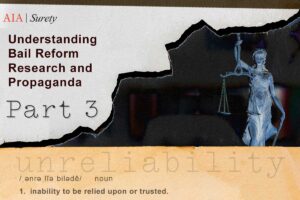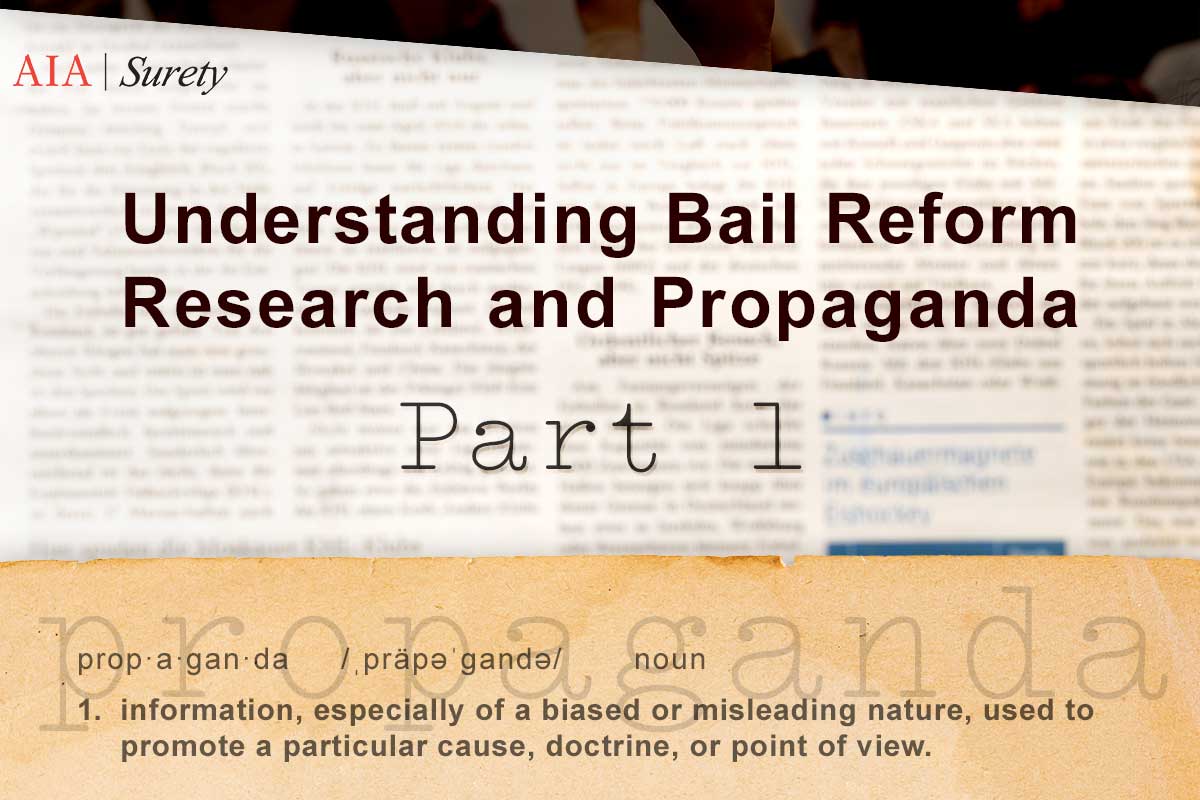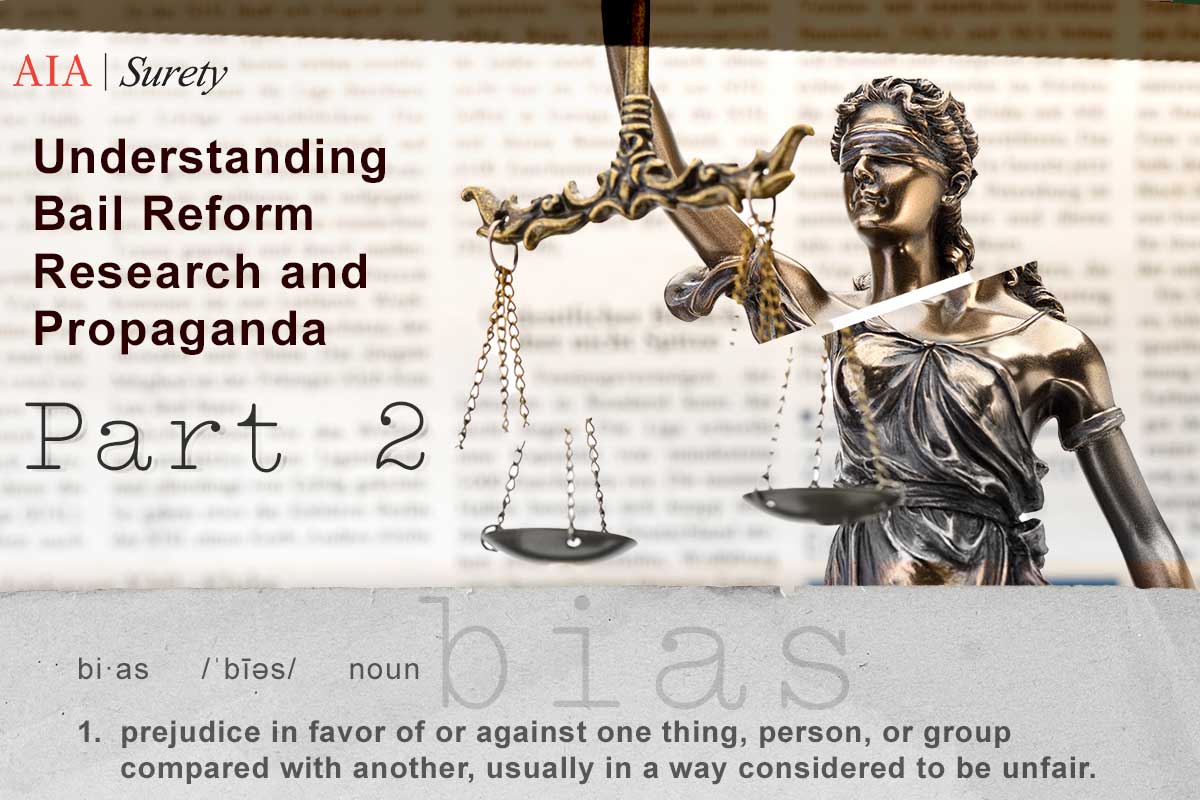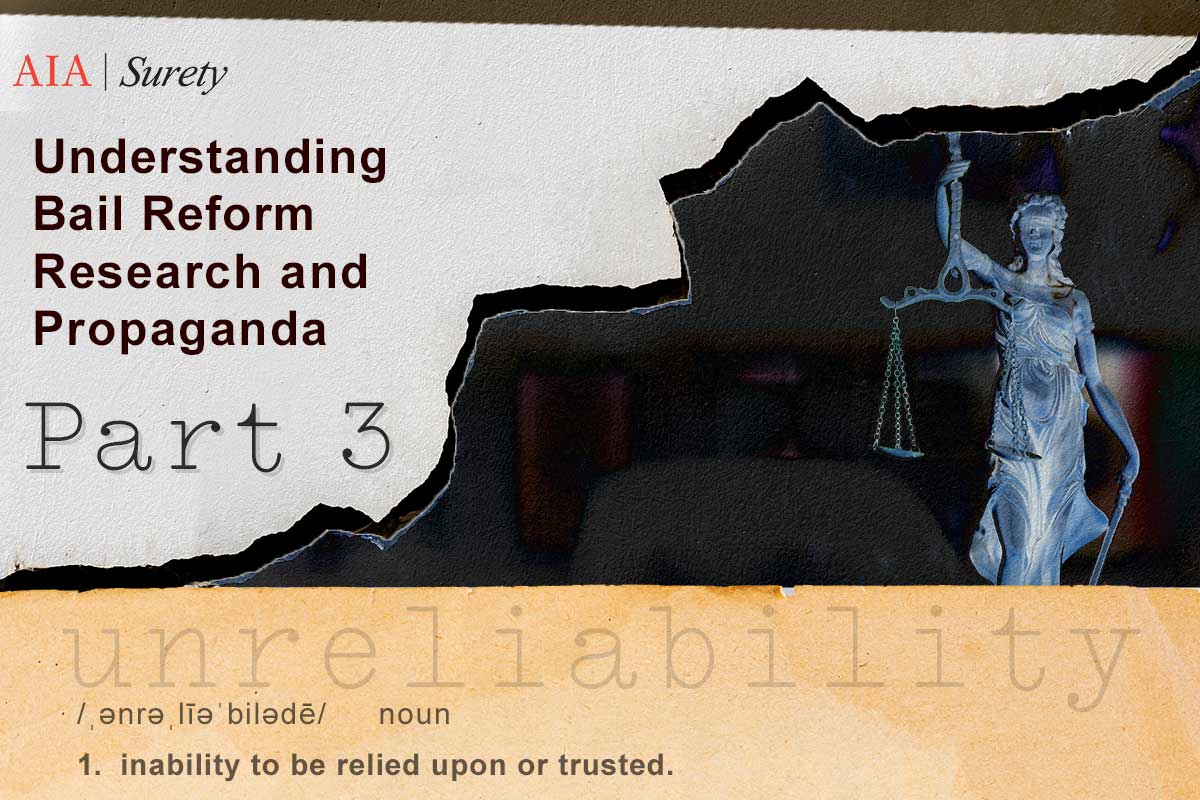Understanding Bail Reform Research and Propaganda (Part 3 of 4):
Harvard Kennedy School Report

We are happy to share the third segment of our series on Bail Reform Research and Propaganda.
We saw in the review of the last two reports from The Brennan Center and The Bail Project that the easiest way to identify the limitations in these studies is to actually read them. As shocking as it sounds, most of the evidence that these reports lack credibility is simple to uncover. You are probably thinking to yourself that it is time that we stop messing around with what are obviously biased entities like the Brennan Center and the Bail Project… two organizations that have publicly criticized surety bail and have called for its elimination in favor of soft on crime cashless bail and free release policies. So, for this next segment, we will look at a study out of one of America’s leading educational institutions, Harvard.
The Current State of Bail Reform In the United States: Results of a Landscape Analysis of Bail Reforms Across All 50 States (PDF)
Harvard Kennedy School
Results of a Landscape Analysis of Bail Reforms Across All 50 States
Sandra Susan Smith and Isabella Jorgensen
December 2021
 The next study (download PDF) we are going to review is from Harvard’s John F. Kennedy School of Government. The study was released in December 2021 and, much like the previous two studies we have reviewed, it is focused on trying to disprove the concept that bail reform policies have increased crime in our communities.
The next study (download PDF) we are going to review is from Harvard’s John F. Kennedy School of Government. The study was released in December 2021 and, much like the previous two studies we have reviewed, it is focused on trying to disprove the concept that bail reform policies have increased crime in our communities.
The study’s objective:
- To review the current state of bail reform throughout the country and assess the various processes that have been implemented and their success.
- Discuss the status of bail reform across the US
- Consider different processes that policy actors have followed
- Look at impact of bail reform on 12 jurisdictions
- Recommend 6 key criteria that jurisdictions should meet
- Discuss risk assessment tools and other areas of concern with current bail reforms
The study’s findings:
After reviewing the various types of bail reforms being implemented across the country, and specifically looking at 12 jurisdictions to see how crime was impacted, the authors found the following,
“For all types of reform, we found no statistically significant difference in post-reform crime trends. These results held when evaluating their effect on rates of crime generally, as well as on property crime, violent crime, and larceny.”
In other words, releasing defendants without secured bail and without any accountability didn’t increase crime…or as they put it…there was no statistically significant difference. The report breaks down the findings for each jurisdiction and as you read about each one, you begin to notice that the results don’t really align with the idea that anything improved. Here are just a few examples from the report.
- Cook County – no significant difference in re-arrest rates
- Jefferson County, CO – no significant difference in re-arrest rates
- Kentucky – 1-2 % increase in re-arrest rates (AN ACTUAL INCREASE!!!)
- New Jersey – 7% increase in re-arrests (ANOTHER INCREASE!!!)
- New York – 3% increase in violent crime (AN INCREASE IN VIOLENT CRIME!!!)
And the same goes for the other states… there was either no change or an actual increase. But remember, the key finding for this research was that bail reform policies are working.
Why is it that every time one of these bail studies comes out the results never show that they are better? They always show that they are just the same as the current system of bail or slightly worse (but blame it on random fluctuations or something like that). Maybe because they know that claiming free release is better than secured release is such a wild claim, they settle for saying it’s just as good, hoping that’s enough to convince people. The problem is that we know from common sense that it just not true. And the idea of spending millions of dollars to fund these programs for results that are just the same as before makes no sense at all. Anyway, lets get back to our review of the report to determine if the report is credible and their claim of “just as good” is true.
The report found that bail reforms lowered the pretrial jail populations. I am not sure that is a real finding. If you implement policies to let more people out of jail for free, a natural outcome would be…less people in jail. If you unlock the cells and leave the front door open, guess what…you will have less people in jail.
As I have pointed out, sometimes all you must do is simply read these reports to find their flaws, and this report is no different. In fact, it didn’t take long to find the first red flag… the very first line of the report says the following:
“The cash bail system punishes people who cannot afford to pay monetary bail by incarcerating them when they have not been convicted of a crime.”
If this sentence sounds familiar, it should. It is one of the most used talking points of the anti-bail movement narrative. Cash bail is unfair…it punishes people…people are languishing away in jail because they can’t afford a bail bond…blah, blah, blah, blah. It really gets tiresome hearing the same old arguments repeatedly. To see this narrative being used in a study from Harvard of all places, and being used in the very first sentence, is not only shocking, but disappointing. However, it doesn’t end there. In the first paragraph, the authors continue to use even more bail reform talking points. Good old classic ones like the following:
- On any given day in the US about 500,000 people are being held pretrial
- They are being held because they cannot afford bail
- People being detained pretrial increases the likelihood someone will be convicted and has negative effects on future employment
- There are substantial racial disparities in the rates of pretrial detention…people of color more likely to be detained pretrial relative to white people
How can one take this research seriously if the authors start out with such biased, non-objective and patently false claims like these. Claims that are misleading at best. In my opinion, it is not a good look for an institution with the reputation of Harvard.
As we continue to read the report, we can see that there is a disclaimer in the front that says:
“The views expressed in the HKS Faculty Research Working Paper Series are those of the author(s) and do not necessarily reflect those of the John F. Kennedy School of Government or of Harvard University. Faculty Research Working Papers have not undergone formal review and approval.”
So, Harvard is willing to put its brand on a report that has not undergone a formal review. One of the criteria that truly makes any research credible is when it is peer reviewed. That means having other “objective” and “non-partisan” researchers examine the report. This peer review process was not done on this research, thus forcing one to question its legitimacy.
Further along in the report, the authors state the following:
“We only listed findings that appeared across multiple studies, so some studies included additional findings that are not discussed in this report… Additionally, not all the studies we examined in our research are included here; we excluded several studies where the analysis was evidently biased or seemed to be low quality.”
This statement raises lots of questions. What type of research did they think was biased? Was research that disagreed with their findings considered low quality? A comment like that makes you believe that they cherry picked the research to get a desired answer. Once again, another red flag when gauging the credibility of this report and its findings.
At another point in the study, the following statement is made:
“Because there is so much variation in the types of bail reforms that have been implemented, the jurisdictions in which they are implemented, and the policy actors who are implementing them, it is difficult to draw conclusions about general impacts of bail reforms. For example, we cannot say with certainty that reforming a bail system will lead to a specific outcome, such as a meaningful decrease in the jail population.”
It is interesting that they are admitting that it is hard to draw conclusions about the effectiveness of bail reform because of the inconsistency in the data but they still can make the conclusion that bail reforms implemented around the country did not impact crime. It really makes no sense.
When evaluating any research, we always like to look at the biography and background of the authors. We looked at the bio of Sandra Smith and noticed that she spent time at the Laura and John Arnold Foundation on their Pretrial Research Advisory Board. The Arnold Foundation is another bail reform activist organization that has been promoting progressive soft on crime policies. They even created and pushed their own risk assessment tool to replace the discretion of judges and force most defendants to be released on cashless bail programs. Based on this background and the rhetoric used in the report, it is hard to consider this report credible.
Lastly, we looked at the sources and endnotes to see what types of other research and articles were used as part of this study. What we found was the same old cast of characters that we have seen in the previous two reports we looked at. This includes, but is not limited to, the Brennan Center, The Vera Institute, The Pretrial Justice Institute, the MacArthur Foundation, and the ACLU to name a few. If you do research on a topic and everyone you talk to shares your extreme position on the topic, it is hard to consider it an objective assessment.
In conclusion, we found the same old story that we found with the two previous research studies, and that we always find with these so called “studies.” They are all big on conclusions and thin on facts. They make the same big claim that bail reforms are working. They do a public relations campaign around the study claiming that secured bail is a myth and that it is ineffective and their study proves it. The stories hit the papers, the news and social media. But when you read through the study, all you see is the same anti-bail talking points and the same activist group sources and citations.
Most of the time, if you just read the study, you will see the authors call out their own study limitations like we have in the three studies we reviewed. I guess our expectation that a Harvard study would provide a more realistic and honest assessment of bail reform was wrong. All we got was just another propaganda piece with a fancy name on it.
Understanding Bail Reform Research and Propaganda Series
The Brennan Center for Justice’s “Bail Reform and Public Safety: Evidence from 33 Cities.”
This study was released last August and has been one of the studies that has been getting the most attention.
Tulsa, Oklahoma Study
The next bail reform research study we are reviewing is currently circulating on social media and other online media sources. This study is based in Tulsa, Oklahoma by The Bail Project
Harvard Kennedy School – December 2021
The next study we are going to review is from Harvard’s John F. Kennedy School of Government. The study was released in December 2021 and, much like the previous two studies we have reviewed, is focused on trying to disprove the concept that bail reform policies have increased crime in our communities.



